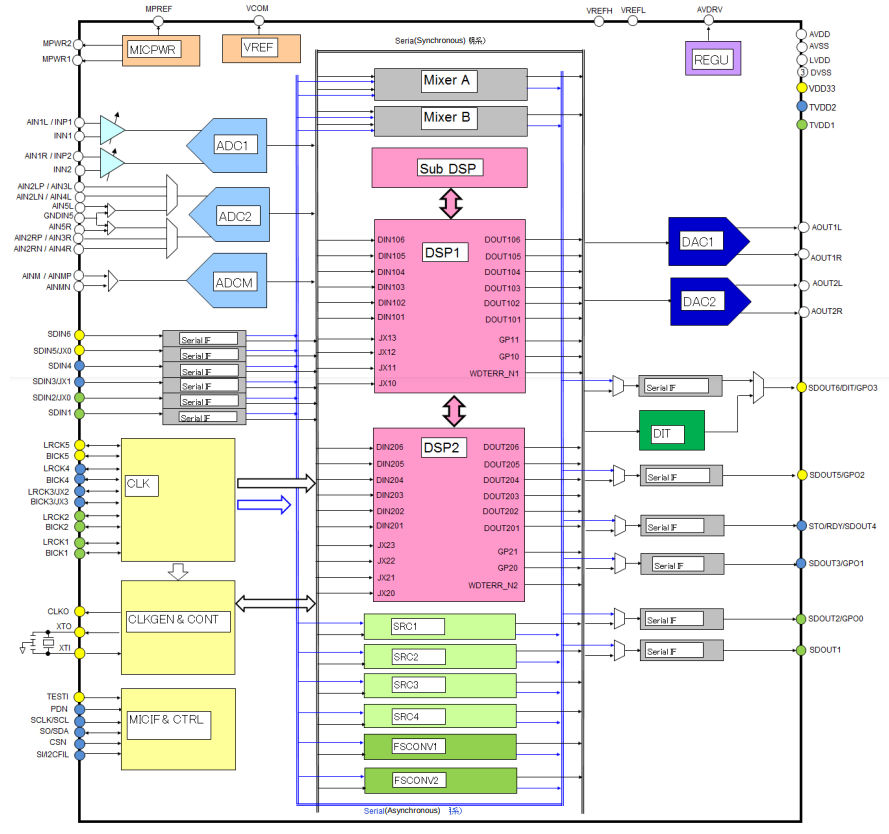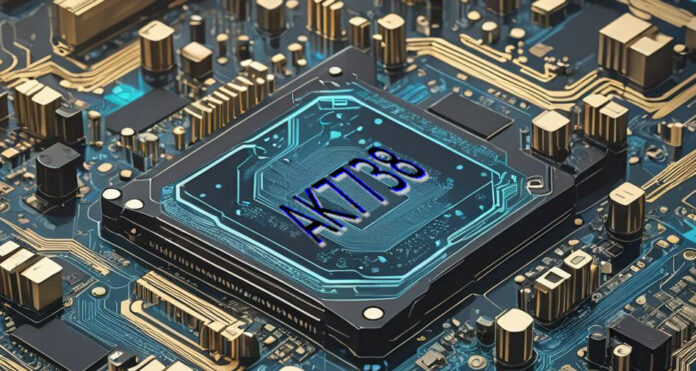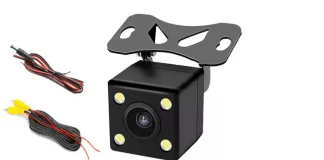The AK7738 DSP can get a mention in some Android Headunit sales documents. But is the AK7738 a good choice for using in an Android Headunit and do you need one of those to get the best sound?
AK
The AK designation is often used by AKM or AshaiKASEI Microdevices company for its Integrated Circuits.
AK7738
The AK7738 is a Digital Signal Processor (DSP) for audio signals providing graphic equalising, surround sound processing and echo cancellation. All these features can be used simultaneously due to the Multi-Core Digital Signal Processor – DSP1 and DSP2 in the block diagram.
The sampling rate in the DAC is at 32 KHz with the design targeting the automotive devices sector.
Two Stereo Analogue to Digital converters are included on the input as ADC1 and ADC2 and a Monaural ADC is shown as ADCM in the diagram.
Output is via the two stereo Digital to Analogue converters shown as DAC1 and DAC2.
Processing of the sound is by the four asynchronous Sample Rate Converters (SRC).
AK7738 Block Diagram

AK7738AVQ
AK7738AVQ is provided in a 64-pin LQFP package.
DSP
The DSP function is often linked to the ‘graphic equalizer’ on the screen to allow visual representation of the adjustments to the sounds being made. The Digital Signal Processing can alter the timing of the sound to each speaker and reduce or boost the bass, midrange and treble with a great level of steps, often up to 32 points of adjustment. The greater the number of adjustment points the more control you have over the sound output.
Because each speaker setup, car interior and listener’s personal preference can be different, the high level of control and adjustment of the sound can be very important. The DSP allow this high level of adjustment and more powerful DSP processors can have a greater level of adjustment.
Summary
The AK7738A is a highly integrated digital signal processor (DSP) with advanced audio processing capabilities. Key features include:
- Audio Processing Components:
- 24-bit stereo ADC with MIC gain amplifiers and input selector.
- 24-bit monaural ADC.
- Two 32-bit stereo DACs.
- Four stereo sampling rate converters, supporting up to 192kHz.
- Two main DSPs and one sub-DSP for audio and hands-free processing, offering 2560 steps/fs (at 48kHz).
- Capabilities:
- Simultaneous processing of sound and voice, suitable for hands-free functions due to synchronized DSP operations.
- The RAM-based architecture allows for customizable programming for various user needs, such as acoustic effects and high-performance hands-free functionality.
- Volume Control and Filters:
- Independent digital volume control (-103dB to 0.5dB steps) for each channel.
- Five types of digital filters for sound colour selection.
- Digital high-pass filters (HPF) for DC offset cancelling.
- Analog-to-Digital Converter (ADC):
- ADC2: 24-bit stereo with input selector, 102dB S/N ratio at 48kHz, supports differential and single-ended inputs.
- ADCM: 24-bit monaural, 102dB S/N ratio at 48kHz, supports differential and single-ended inputs.
- Digital-to-Analog Converter (DAC):
- Advanced 32-bit DACs with single-ended output, -115dB S/N ratio at 48kHz.
- Digital Interface and Mixer:
- Supports S/PDIF, IEC60958, AES/EBU, EIAJ CP1201 standards.
- 24-bit stereo output, TDM format support, up to 24 input and 28 output channels.
- Independent LRCK/BICK input ports.
- Data formats: MSB 32, 24-bit / LSB I2S, PCM short/long frame.
- Control and Power:
- Digital mixer and PLL circuit.
- Interfaces: SPI (up to 6MHz), I2C-bus (400kHz fast mode, 1MHz fast mode plus).
- Power supplies: Analog AVDD and digital LVDD up to 3.6V, with integrated 1.2V regulator.
- Operating temperature: up to 85°C.
- Package: 64-pin LQFP, 10mm size, 0.5mm pitch.
The AK7738A is designed for flexible, high-quality audio processing in various applications, offering extensive configurability and robust performance.
Conclusion
Having a DSP chip – also known as DSP in hardware will often perform better than DSP in software in some situations. While DSP in software can work well, the DSP function in software shares the processing power with the main processing function. If the DSP needs processor time and the Android system needs processor time, one will have to lose out.
The advantage of a hardware DSP is that it won’t affect the processor and the apps it runs. Any sound processing required is not touched by the processor and all the DSP is done in the DSP chip. Having a discrete hardware DSP function is advantageous over having to use DSP in software.
You don’t need a DSP, but if you want to adjust the sound, use a graphic equalizer or alter the timing to each of the speakers then you need a DSP and a hardware DSP is better.








